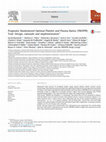Papers by Terence O'Keeffe

JAMA surgery, Jan 24, 2015
The role of acute care surgeons is evolving; however, no guidelines exist for the selective treat... more The role of acute care surgeons is evolving; however, no guidelines exist for the selective treatment of patients with traumatic brain injury (TBI) exclusively by acute care surgeons. We implemented the Brain Injury Guidelines (BIG) for managing TBI at our institution on March 1, 2012. To compare the outcomes in patients with TBI before and after implementation of the BIG protocol. We conducted a 2-year analysis of our prospectively maintained database of all patients with TBI (findings of skull fracture and/or intracranial hemorrhage on an initial computed tomographic scan of the head) who presented to our level I trauma center. The pre-BIG group included patients with TBI from March 1, 2011, through February 29, 2012, and the post-BIG group included patients from July 1, 2012, through June 30, 2013. The primary outcome measures were patients with repeated computed tomography of the head and neurosurgical consultations. Secondary outcome measures were findings of progression of int...

American journal of surgery, Jan 16, 2015
Organ donation after cardiac death (DCD) is not optimal but still remains a valuable source of or... more Organ donation after cardiac death (DCD) is not optimal but still remains a valuable source of organ donation in trauma donors. The aim of this study was to assess national trends in DCD from trauma patients. A 12-year (2002 to 2013) retrospective analysis of the United Network for Organ Sharing database was performed. Outcome measures were the following: proportion of DCD donors over the years and number and type of solid organs donated. DCD resulted in procurement of 16,248 solid organs from 8,724 donors. The number of organs donated per donor remained unchanged over the study period (P = .1). DCD increased significantly from 3.1% in 2002 to 14.6% in 2013 (P = .001). There was a significant increase in the proportion of kidney (2002: 3.4% vs 2013: 16.3%, P = .001) and liver (2002: 1.6% vs 2013: 5%, P = .041) donation among DCD donors over the study period. DCD from trauma donors provides a significant source of solid organs. The proportion of DCD donors increased significantly ove...
Journal of Surgical Research, 2014

American journal of surgery, 2014
We hypothesized that patients with acute mild gallstone pancreatitis (GSP) admitted to surgery (S... more We hypothesized that patients with acute mild gallstone pancreatitis (GSP) admitted to surgery (SUR; vs medicine [MED]) had a shorter time to surgery, shorter hospital length of stay (HLOS), and lower costs. We performed chart reviews of patients who underwent a cholecystectomy for acute mild GSP from October 1, 2009 to May 31, 2013. We excluded patients with moderate to severe and non-gallstone pancreatitis. We compared outcomes for time to surgery, HLOS, costs, and complications between the 2 groups. Fifty acute mild GSP patients were admitted to MED and 52 to SUR. MED patients were older and had more comorbidity. SUR patients had a shorter time to surgery (44 vs 80 hours; P < .001), a shorter HLOS (3 vs 5 days; P < .001), and lower hospital costs ($11,492 ± 6,480 vs $16,183 ± 12,145; P = .03). In our subgroup analysis on patients with an American Society of Anesthesiologists score between 1 and 2, the subgroups were well matched; all outcomes still favored SUR patients. Adm...

American journal of surgery, Jan 27, 2014
The current literature regarding hemorrhagic complications in patients on long-term antiplatelet ... more The current literature regarding hemorrhagic complications in patients on long-term antiplatelet therapy undergoing emergent laparoscopic cholecystectomy is limited. The aim of our study was to describe hemorrhagic complications in patients on prehospital aspirin (ASP) therapy undergoing emergent cholecystectomy. We performed a 1-year retrospective analysis of our prospectively maintained acute care surgery database. The 2 groups (ASP group vs No ASP group) were matched in a 1:1 ratio for age, sex, previous abdominal surgeries, and comorbidities. Primary outcome measures were intraoperative hemorrhage, postoperative anemia, need for blood transfusion, and conversion to open cholecystectomy. Intraoperative hemorrhage was defined as intraoperative blood loss of ≥100 mL; postoperative anemia was defined by ≥2 g/dL drop in hemoglobin. A total of 112 (ASP: 56, no ASP: 56) patients were included in the analysis. The mean age was 65.9 ± 10 years, and 50% were male. There was no difference ...
Journal of the American College of Surgeons, 2015
The American Journal of Surgery, 2014
Journal of Trauma and Acute Care Surgery, 2013
Journal of Surgical Research, 2014
The American Journal of Surgery, 2014

Injury, 2014
Forty percent of in-hospital deaths among injured patients involve massive truncal haemorrhage. T... more Forty percent of in-hospital deaths among injured patients involve massive truncal haemorrhage. These deaths may be prevented with rapid haemorrhage control and improved resuscitation techniques. The Pragmatic Randomized Optimal Platelet and Plasma Ratios (PROPPR) Trial was designed to determine if there is a difference in mortality between subjects who received different ratios of FDA approved blood products. This report describes the design and implementation of PROPPR. PROPPR was designed as a randomized, two-group, Phase III trial conducted in subjects with the highest level of trauma activation and predicted to have a massive transfusion. Subjects at 12 North American level 1 trauma centres were randomized into one of two standard transfusion ratio interventions: 1:1:1 or 1:1:2, (plasma, platelets, and red blood cells). Clinical data and serial blood samples were collected under Exception from Informed Consent (EFIC) regulations. Co-primary mortality endpoints of 24h and 30 day...

JAMA, Jan 3, 2015
Severely injured patients experiencing hemorrhagic shock often require massive transfusion. Earli... more Severely injured patients experiencing hemorrhagic shock often require massive transfusion. Earlier transfusion with higher blood product ratios (plasma, platelets, and red blood cells), defined as damage control resuscitation, has been associated with improved outcomes; however, there have been no large multicenter clinical trials. To determine the effectiveness and safety of transfusing patients with severe trauma and major bleeding using plasma, platelets, and red blood cells in a 1:1:1 ratio compared with a 1:1:2 ratio. Pragmatic, phase 3, multisite, randomized clinical trial of 680 severely injured patients who arrived at 1 of 12 level I trauma centers in North America directly from the scene and were predicted to require massive transfusion between August 2012 and December 2013. Blood product ratios of 1:1:1 (338 patients) vs 1:1:2 (342 patients) during active resuscitation in addition to all local standard-of-care interventions (uncontrolled). Primary outcomes were 24-hour an...

Journal of Surgical Research, 2014
Brain Trauma Foundation (BTF) guidelines recommend intracranial pressure (ICP) monitoring for tra... more Brain Trauma Foundation (BTF) guidelines recommend intracranial pressure (ICP) monitoring for traumatic brain injury (TBI) patients with a Glasgow Coma Scale score of 8 or less with an abnormal head computed tomography, or a normal head computed tomography scan with systolic blood pressure ≤90 mm Hg, posturing, or in patients of age ≥40. The benefits of these guidelines on outcome remain unproven. We hypothesized that adherence to BTF guidelines for ICP monitoring does not improve outcomes in patients with TBI. All TBI patients with an admission Glasgow Coma Scale ≤8 admitted to our level I trauma center over a 3-y period were identified. Adherence to the individual components of our institutional TBI Bundle (ICP monitoring, SpO2 ≥95%, PaCO2 30-39 mm Hg, systolic blood pressure ≥90 mm Hg, cerebral perfusion pressure ≥60 mm Hg, ICP ≤25 mm Hg, and temperature 36°C-37°C) was assessed. Patients were stratified into two groups as follows: patients with ICP monitoring (ICP) and patients without ICP monitoring (no-ICP). Outcome measures were survival and discharge disposition. Multivariate regression analysis was performed. We identified 2618 TBI patients, 261 of whom met the BTF criteria for ICP monitoring. After excluding those with nonsurvivable injuries (n = 67), 194 patients were available for analysis. The two groups were similar in demographics and severity of head injury. Survival rate was higher in the no-ICP group compared with that in the ICP group (98% versus 76%, P &amp;amp;amp;amp;amp;amp;amp;amp;amp;amp;amp;amp;amp;amp;amp;amp;amp;amp;amp;amp;amp;amp;amp;amp;amp;amp;amp;amp;amp;amp;amp;amp;amp;amp;amp;amp;amp;amp;amp;amp;amp;amp;amp;amp;amp;amp;amp;amp;amp;amp;amp;amp;amp;amp;amp;amp;amp;amp;amp;amp;amp;amp;amp;amp;amp;amp;amp;amp;amp;amp;amp;amp;amp;amp;amp;amp;amp;amp;amp;amp;amp;amp;amp;amp;amp;amp;amp;amp;lt; 0.004). Non-monitored patients were discharged with higher levels of function per discharge location (28% home versus 4% home; P &amp;amp;amp;amp;amp;amp;amp;amp;amp;amp;amp;amp;amp;amp;amp;amp;amp;amp;amp;amp;amp;amp;amp;amp;amp;amp;amp;amp;amp;amp;amp;amp;amp;amp;amp;amp;amp;amp;amp;amp;amp;amp;amp;amp;amp;amp;amp;amp;amp;amp;amp;amp;amp;amp;amp;amp;amp;amp;amp;amp;amp;amp;amp;amp;amp;amp;amp;amp;amp;amp;amp;amp;amp;amp;amp;amp;amp;amp;amp;amp;amp;amp;amp;amp;amp;amp;amp;amp;lt; 0.001). Patients without ICP monitoring were 1.21 times more likely to survive compared with that of patients with ICP monitoring (odds ratio: 1.21, 95% confidence interval [1.1-1.9], P = 0.01). In the ICP group, the overall compliance rate to the ICP and cerebral perfusion pressure goals as required by the BTF guidelines was poor. Our data suggest that there is a subset of patients meeting BTF criteria for ICP monitoring that do well without ICP monitoring. This finding should provoke reevaluation of the indication and utility of ICP monitoring in TBI patients.
World Journal of Surgery, 2014

The American Journal of Surgery, 2013
Alcohol use may alter mental status and vital signs in injured patients, leading to increased tes... more Alcohol use may alter mental status and vital signs in injured patients, leading to increased testing during emergency department (ED) evaluation. We hypothesized that alcohol use increases the hospital charges when caring for these injured patients. The National Hospital Ambulatory Medical Care Survey collects weighted population-based estimates of ED use. We analyzed injury-related visits of adult patients, and resource use and admission rates were compared by the presence of alcohol. Alcohol was involved in 6.0% of injury-related ED visits. Alcohol-present patients arrived by ambulance more frequently (45% vs 21%, P &amp;amp;amp;amp;amp;amp;amp;amp;amp;amp;amp;amp;amp;amp;amp;amp;amp;amp;amp;amp;amp;amp;amp;amp;amp;amp;amp;amp;amp;amp;amp;amp;amp;amp;amp;amp;amp;amp;amp;amp;amp;amp;amp;amp;amp;amp;amp;amp;amp;amp;amp;amp;lt; .001), had a 26% longer ED stay (211 vs 167 minutes, P &amp;amp;amp;amp;amp;amp;amp;amp;amp;amp;amp;amp;amp;amp;amp;amp;amp;amp;amp;amp;amp;amp;amp;amp;amp;amp;amp;amp;amp;amp;amp;amp;amp;amp;amp;amp;amp;amp;amp;amp;amp;amp;amp;amp;amp;amp;amp;amp;amp;amp;amp;amp;lt; .001), and underwent more diagnostic testing. They were twice as likely to be admitted (14.0% vs 6.5%, P &amp;amp;amp;amp;amp;amp;amp;amp;amp;amp;amp;amp;amp;amp;amp;amp;amp;amp;amp;amp;amp;amp;amp;amp;amp;amp;amp;amp;amp;amp;amp;amp;amp;amp;amp;amp;amp;amp;amp;amp;amp;amp;amp;amp;amp;amp;amp;amp;amp;amp;amp;amp;lt; .001). Additional ED charges were over $217 million. Patients with alcohol-related injuries use significantly more resources, with a significant added financial burden. Insurance companies in many states can deny coverage for injuries caused by alcohol use, shifting these expenses to trauma centers.
The American Journal of Surgery, 2010
Telemedicine and e-Health, 2014
Uploads
Papers by Terence O'Keeffe